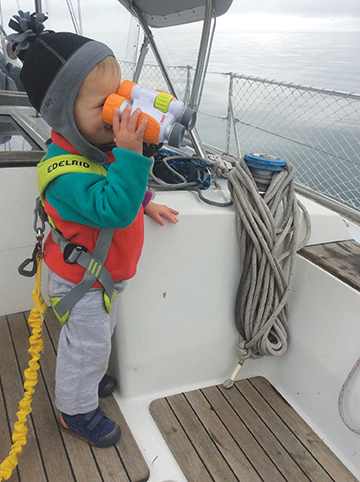Whether racing offshore or cruising, taking stock of a “safety equipment requirements and recommendations” list will show you what safety gear you have, but more importantly, what you don’t (published May 2015)
When Jill and I consider our future sailing endeavors aboard Yahtzee, cruising as a family is the answer. But we also love to race and are now thinking about entering longer distance events to see if they are something we enjoy doing. There are a few good ones that make our list here in the Pacific Northwest— Swiftsure and Oregon Offshore to name two—and several other even longer distance races that might be fun to enter someday—Vic Maui and the Van Isle 360.
In preparing for offshore racing or cruising, we wanted to make sure our boat was up to snuff safety wise, so we downloaded the Safety Equipment Requirements (SER) for the Oregon Offshore Race and compared it with lists from other offshore races including the Marion to Bermuda Cruising Yacht Race. We also grabbed a copy of the 2014-2015 US Safety Equipment Requirements & ISAF Offshore Special Regulations. The reason for doing this is that these events have been run for a long time, which means their safety requirements have been refined over years of practical application. In the end, we figured that combing through our boat with these lists would get us prepared if we do choose to enter a race, but will also help in being properly equipped for our current cruising adventures as well.
What we learned from comparing these safety lists to our boat’s gear is that no matter how prepared we think we are, and whether items are “required” or “recommended”, there is always room to upgrade our onboard safety equipment and seamanship skills. Here is some of what we found and what we’ll improve upon.
PERSONAL & ON DECK SAFETY
Personal safety is paramount when the boat leaves the dock, and it’s more than just the old maxim, “one hand for you, one for the boat.” Every crewmember needs to have a safety harness and tether. Tethers should be no longer than seven feet and should have a means to allow for a quick disconnect under load. Lifejackets are obviously a must, but they should be specific to the wearer, have a leg or crotch strap, a whistle, a waterproof light, be fitted with marine-grade retro-reflective material, and be clearly marked with the boat’s or wearer’s name. They should also be compatible with the wearer’s safety harness.
We didn’t have leg straps for either of our PFDs and a light for one of them, so we grabbed a SEE-ME Personal Locator strobe from West Marine and put the straps on our list. A waterproof flashlight for each crewmember is also required, and it is a good idea for everyone to have a knife and headlamp as well. We needed to upgrade our knife, headlamp and flashlight situation, so those went on the list too. And speaking of knives, one should be secured somewhere in the cockpit or on deck where it is easily reachable by all crew. And a high-powered spotlight should be readily available.
PLBs are not currently required, but are encouraged by many experts in the field and should be seriously considered for every crewmember.
The boat should have jacklines rigged to allow the crew to clip on before coming on deck and to unclip after going below. There should also be adequate places for on watch crew to clip into the cockpit; permanently installed padeyes are the most common choice.
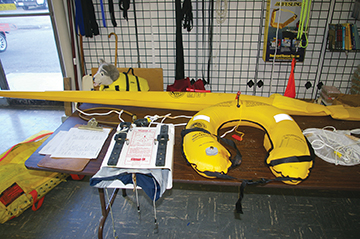
A LifeSling™ or equivalent device should be stored on deck and ready to use at a moments notice, as should a 50-foot throw rope. In addition to that, boats are required to have a man overboard pole and flag with a lifebuoy, a self-igniting light, a whistle and a drogue attached. A self-inflating MOB module such as a MOM-8, Dan Buoy or similar device will satisfy this requirement and they should be tested and serviced in accordance with the manufacturer’s specifications. These items should be stored on deck, ready for immediate use, and affixed in a manner that allows for a quick release. It is a good idea to stencil the boat’s name on all safety gear and life raft. In the instance of gear like life rafts and MOM-8s, you’ll have to do this when you have it serviced next. This one went on our list for our next raft and MOM-8A servicing.
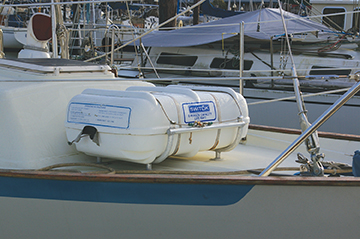 Our life raft fulfills all requirements, but it is housed in a valise and is currently stowed down below so that it is not exposed to the elements. While sailing offshore, though, life rafts should be stored in such a way that they are capable of being launched within 15 seconds. We are currently looking into the best options for on deck storage so that we don’t have to lug it up the companionway steps in the event of an emergency. We are also in the process of upgrading our grab/ditch bag, as the requirement here is for a bright colored bag that can float. At a minimum it should contain an EPIRB and waterproof VHF, which can also be counted as part of the ship’s gear. (See the May 2014 issue of BWS for an in depth look at life rafts and ditch bags.)
Our life raft fulfills all requirements, but it is housed in a valise and is currently stowed down below so that it is not exposed to the elements. While sailing offshore, though, life rafts should be stored in such a way that they are capable of being launched within 15 seconds. We are currently looking into the best options for on deck storage so that we don’t have to lug it up the companionway steps in the event of an emergency. We are also in the process of upgrading our grab/ditch bag, as the requirement here is for a bright colored bag that can float. At a minimum it should contain an EPIRB and waterproof VHF, which can also be counted as part of the ship’s gear. (See the May 2014 issue of BWS for an in depth look at life rafts and ditch bags.)
EMERGENCY COMMUNICATIONS
There are more options for onboard communications than ever before and many offshore events are requiring multiple devices. It seems obvious that you’ll be required to have a GPS, but you’ll probably have to rent a tracking device to help organizers and spectators watch the fleet as it progresses towards the finish line.
Even though a tracker might be a race requirement, we decided to get a Delorme InReach that we can activate the service on whenever we need to or through a yearly plan. Having a satellite tracker like this allows us to send and receive 160-character text messages, send out an SOS and track our voyage, plus it easily pairs with the Earthmate mobile app to make communications easier.

VHFs should have a permanent connection to the masthead as well as a backup antenna. It is recommended that all radios have DSC capability, have an antenna of at least 15-inches in length, be connected to or have an internal GPS, and have the assigned MMSI number (unique to the boat) programed into it.
In addition to a fixed mount VHF, you should also have a watertight handheld VHF radio or a handheld VHF radio with waterproof case and the recommendation here is that the radio have DSC/GPS capability as well. We have a waterproof handheld VHF, but in the interest of safety and redundancy, we decided to upgrade to the Standard Horizon HX870. Its impressive list of functions includes Class D Digital Selective Calling with a separate receiver for Channel 70, a WAAS-enhanced GPS receiver that can store 200 waypoints and 20 routes, and the ability to double as a MOB beacon, to name a few.
Other requirements or recommendations that I could find included but were not limited to an AIS, HF Radio, cellular telephone housed in a waterproof case, Satellite phone housed in a waterproof case that can be operated from down below using an external antenna, and a means of obtaining weather information other than through a VHF.
On top of all that, boats should be equipped with a 406MHz EPIRB that is properly registered to the boat and it is recommended that this device have either an internal GPS (self-locating) or be connected to a continuously functioning external GPS. This EPIRB can also accompany you in your life raft if the need were to arise.
HULL OPENINGS & PUMPS
I’d be remiss here if I didn’t mention the need for high quality, high volume, manual bilge pumps and the ability to drain the cockpit in a sufficient manner. Having a permanently installed manual bilge pump of at least a 10 gallons per minute (GPM) capacity that is operable from on deck with the cabin closed and with the discharge not dependent on an open hatch is a must. And unless a bilge pump handle is permanently attached to the pump, it should be attached to the boat with a lanyard or catch. Also, the bilge pump’s discharge should not be connected to a cockpit drain and should not discharge into a cockpit unless it opens aft to the sea. You should also have a second manual bilge pump of at least 10 GPM capacity that is operable from below deck and meets the same criteria as above. And the old saying holds true that, “there is nothing more efficient than a sinking sailor with a bucket,” as two sturdy, two gallon buckets with lanyards is a requirement. We needed an extra bucket.
Along with being able to pump water out, you have to keep it from coming in in the first place. Companionways need to be watertight and if you have interlocking removable washboards, as we do, they must be attached to the boat with a lanyard so they cannot be lost overboard. We’re still figuring out a way to satisfy this requirement.
Through-hull openings below the waterline are an obvious incursion point for water, and each should have an appropriately sized bung next to it. It is also a requirement to have a posted waterproof placard denoting where all through-hulls are located, along with the vessel’s safety equipment. We have a fairly thorough diagram of Yahtzee, but need to update the location of some safety equipment.
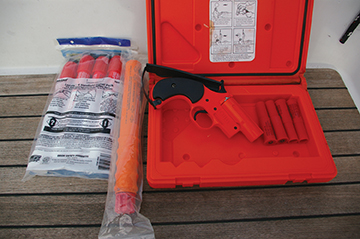
FLARES
Our boat is currently compliant with Coast Guard regulations in regards to flares, but we need a hefty upgrade in this department to satisfy race requirements. When all is said and done, we’ll end up with a flare inventory of two SOLAS orange smoke flares, six SOLAS red parachute flares and four SOLAS red hand flares that are not older than their expiration dates. I’m also looking into non-pyrotechnic flares that can be used as a backup.
SKILLS
From what I can tell, every offshore race and many coastal races in North America require at least 30 percent of a boat’s crew, including the person in charge, to take an approved Safety At Sea seminar. There is a reason for this: they are informative, well run and will greatly improve the overall safety of everyone aboard in the event of an emergency. Cruisers and racers participate in teaching and taking these courses, and from pyrotechnics to storm sail handling, there is a ton of great info to be gleaned from an SAS seminar. Attending a one- or two-day seminar went to the top of our list and Jill was able to attend one in Portland, Oregon (read about her SAS experience on page 47.)
It is a requirement that a boat carry an appropriate emergency tiller and that all crewmembers know where it is and how it is fitted and used. But the crew is also required to be aware of multiple methods of steering the boat with the rudder disabled, and should have chosen and practiced one method of steering the boat with the rudder disabled and be prepared to demonstrate this method of steering both upwind and downwind.
We have an emergency tiller, but we also have a Hydrovane, which works independently of our main rudder and can be used as an emergency rudder. We’ve never used it as such and need to practice operating the boat with it more often so we are comfortable handling it in all conditions.
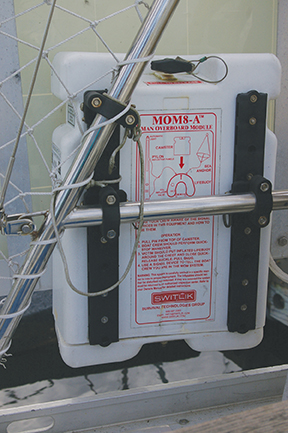 A crew overboard maneuver is never something any sailor wants to do in a real-world situation, and the requirement is that crew shall practice man-overboard procedures appropriate for the boat’s size and speed. This practice should consist of marking and returning to a position on the water, and demonstrating a method of hoisting a crewmember back on deck, or other consistent means of reboarding the crewmember. When was the last time you practiced a crew overboard maneuver?
A crew overboard maneuver is never something any sailor wants to do in a real-world situation, and the requirement is that crew shall practice man-overboard procedures appropriate for the boat’s size and speed. This practice should consist of marking and returning to a position on the water, and demonstrating a method of hoisting a crewmember back on deck, or other consistent means of reboarding the crewmember. When was the last time you practiced a crew overboard maneuver?
Lastly, it is highly recommended that at least two crewmembers have CPR and First Aid certifications, and this is something we both needed to get current on. Better yet, we are looking into taking a Wilderness First Aid course that is specific to sailing and will then add any necessary pieces to our onboard first aid kit, which is also a requirement.
After thoroughly going through Yahtzee’s onboard equipment it became quite obvious that while we have the vast majority of the required or recommended items, especially some of the big-ticket items like storm sails and life raft, there were definitely some holes to be found. We were able to fill some of them right away and are now looking at a list that isn’t too daunting to complete. The above was just a portion of the requirements lists we looked at, so whether you are competing in an offshore race or cruising rally, or just setting out on your own, I would highly recommend going online, downloading one of these checklists and applying it to your boat—you might be surprised at what you find…or don’t.

















